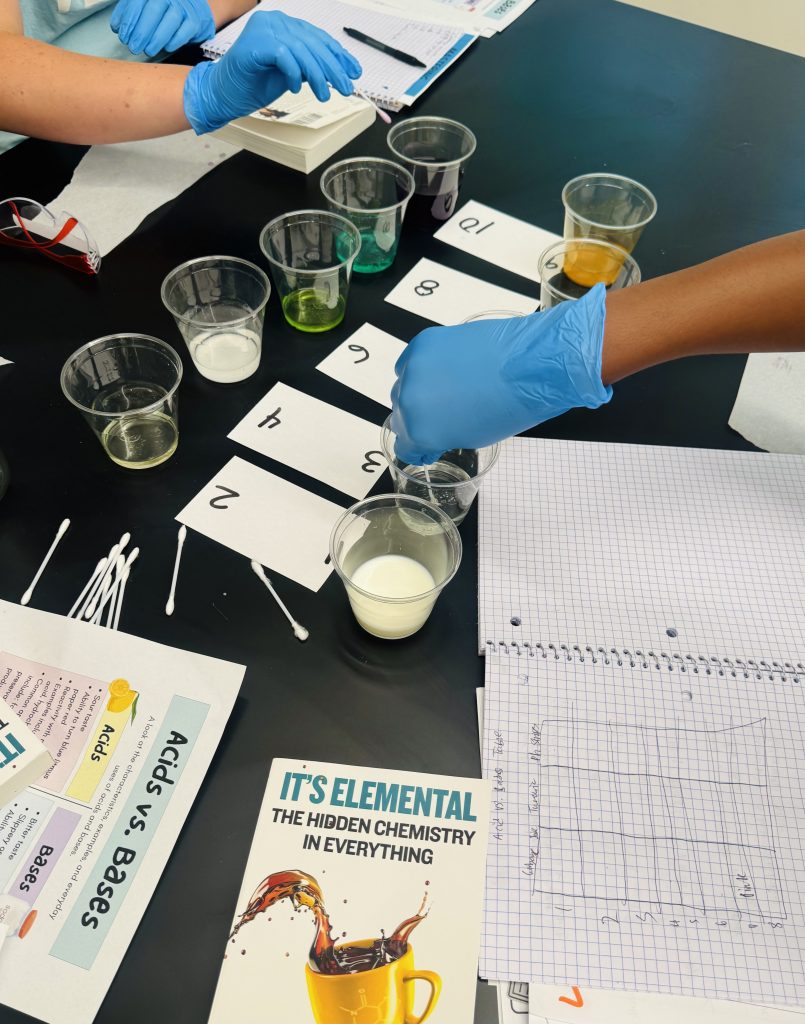Summer SAVY, Session 5 Day 5, “Hidden Chemistry: Everyday Chemical Reactions” (7th-8th)
SAVY Families,
Today marked the final day of our journey through Hidden Chemistry: Everyday Chemical Reactions, and what an exciting conclusion it was! Your children have spent the week exploring the invisible forces and chemical reactions that shape the world around them, and today, we dove into the intriguing world of acids, bases, and pH.
We began the day with a fun and interactive icebreaker where students identified their favorite foods and drinks as acidic, basic, or neutral. From the sour tang of lemons to the bitterness of coffee and the slipperiness of soapy dish detergent, students were amazed to realize how pH influences their daily experiences in the kitchen, at the dinner table, and even when brushing their teeth. This discussion opened their eyes to how acids and bases affect taste, cleaning power, and even the way our bodies maintain balance for health and survival.
Building on this curiosity, students learned about the pH scale and how it measures the concentration of hydrogen ions in a solution. They explored why substances like vinegar and lemon juice are acidic, while baking soda and soap are basic, and how these properties determine their roles in cooking, cleaning, medicine, and nature. We discussed real-world applications, such as how farmers adjust soil pH to support healthy crops, how acidic environments prevent food spoilage in pickling, and how the human stomach uses hydrochloric acid to digest food efficiently.
For our final project, students conducted pH testing experiments using homemade red cabbage juice and turmeric indicators to test the acidity or basicity of various household substances, including lemon juice, baking soda, vinegar, soap, and milk. They formed hypotheses, carefully recorded their observations, and analyzed color changes to determine pH values. It was incredible to see their excitement as the cabbage juice changed from purple to pink or blue depending on the solution’s pH. This experiment allowed them to apply their chemistry knowledge in practical, creative, and engaging ways, sparking many “aha” moments of understanding.
We then explored the “Magic Milk” experiment, where students observed swirling color patterns formed when vinegar and baking soda were added to milk mixed with food coloring. This reaction, caused by the production of carbon dioxide gas during an acid-base neutralization, illustrated the principles of chemical change and molecular interaction colorfully and memorably.
At home, I encourage you to ask your child about their discoveries today. Here are some “Think Beyond” questions to guide your conversations:
- How does pH influence chemical reactions and processes?
- What are examples of acids and bases in daily life, and how do they impact us?
- What happens when an acid like vinegar is added to a pH indicator such as cabbage juice?
- Why is understanding acids and bases important in science, health, cooking, and industry?This week, your children acted as true chemists, asking thoughtful questions, designing experiments, interpreting data, and making discoveries about the hidden chemistry all around them. Their creativity, curiosity, and enthusiasm have been inspiring to witness each day. They leave this course with a deeper appreciation for the scientific principles that govern the world and with skills that will serve them in future STEM learning and beyond.
Thank you for entrusting me with your children’s learning this week. It has been an absolute privilege to teach such bright and engaged young scientists. I hope this experience has sparked in them a lifelong curiosity to question, explore, and understand the world through the lens of chemistry.
Warmest regards,
Ms. Hannah Richards
